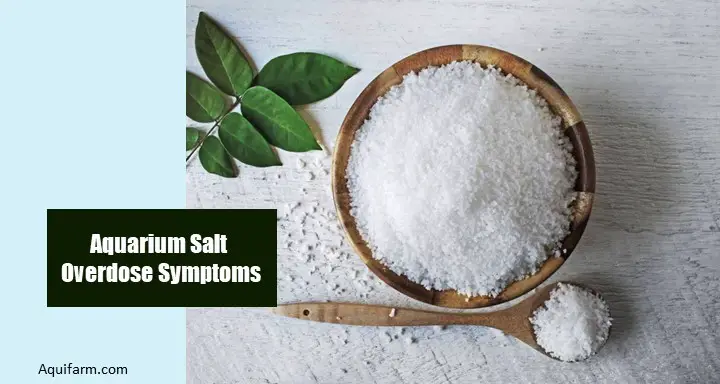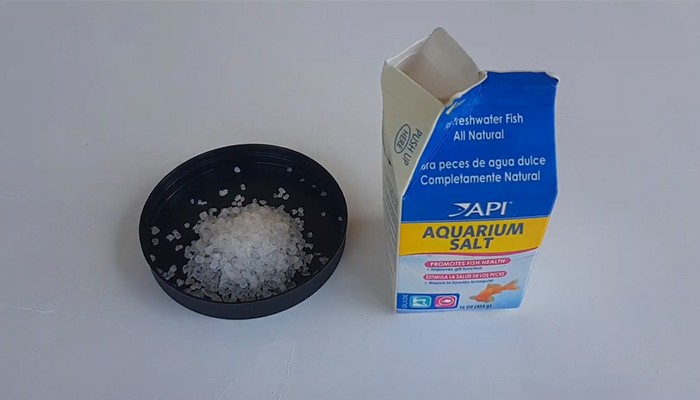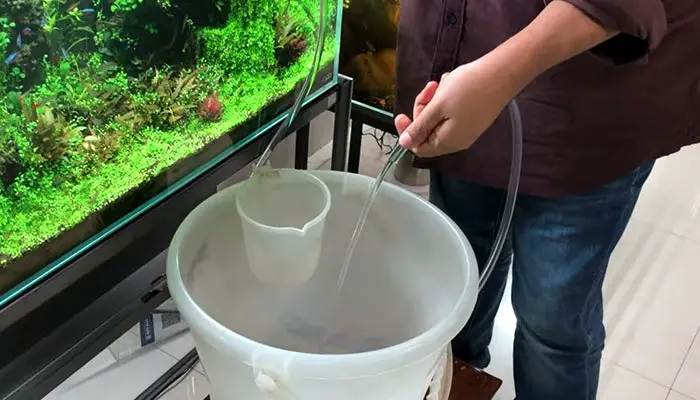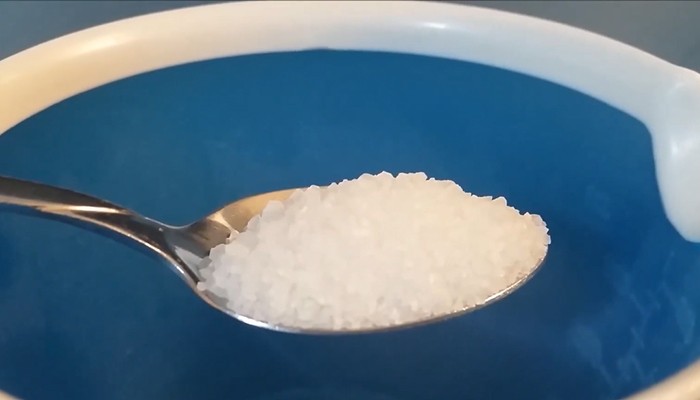
Salt is very commonly used to get rid of various kinds of parasites, bacterial and fungal infections, and other diseases of fish and plants in the aquarium. But sometimes you mistakenly or unknowingly put in more salt than it actually needs.
The overdose of salt harms the plants and animals in the tank that you do not want. In this article, you are going to know the effects and symptoms of salt overdose in your aquarium and its solution as well.
Salt overdose in aquariums results mainly in “Dehydration”. The fish lose appetite, get sick and plants start dying or changing color, fish are seen to dart around or hide behind rocks and other things.
What Are The Symptoms Of Salt Overdose In Aquariums

1. Dehydration
Dehydration means a lack of water in the body of an organism. When a body somehow loses its necessary amount of water, it becomes unable to function in its internal activity. As a result, it becomes sick.
When an extra amount of salt is applied in an aquarium, the water in it starts sucking the water out from the fish and other animals in the tank. This process is called “Osmosis”.
In this process, water gets transferred from a solution of lower density to a solution of higher density. After adding an excess amount of salt to the tank, the density of tank water gets higher than the density of the water that is in a fish’s body. So gradually the tank water sucks out a significant amount of water from the body of the fish and the fish lack the necessary amount of water, which ultimately results in dehydration.
2. Sickness In Fish And Plants
Because of dehydration and lack of the necessary amount of water in their body, they become sick and sometimes they die as well.
The same thing happens with the plants in the tank. The tank water sucks out the water and some essential minerals from the plants and they can not conduct essential internal activities including photosynthesis.
As a result, the plants start getting sick and changing color and can die in extreme cases.
3. Restlessness In Fish
The fish in the tank actually seek to escape the toxic environment of the tank. This is why they restlessly swim about from one corner of the tank to another.
But unfortunately, they can not find a way out of the tank and become exhausted which leaves a bad impact on their health. This is how they get themselves one step ahead of sickness.
4. Fish Hide Themselves
After swimming about the whole tank they can not find a way out. They get tired and try to hide behind rocks and other things that are in the tank. They think this act can save them from the salty environment but they fail.
4. Gasping For Air Near The Surface
When an excessive amount of salt is put in a tank, in that salty environment the fish can not breathe properly.
So, the fish stay close to the surface and gather there to get fresh air as it is not available at the bottom of the tank.
6. Rubbing Against Rock Or Gravel
Because of the excessive amount of salt in the water, the salt sometimes settles on the skin of the fish and creates irritation for them.
Just to get rid of this irritation, fish rub their bodies against a rock or gravel hoping to have clear and fresh skin.
It is a significant sign that is seen in the fish when an excessive amount of salt is applied.
7. Loss Of Appetite
This is also a prominent symptom that is commonly observed in fish.
If you see that the fish are not eating enough or they are eating less than they eat normally and a fair amount of leftover food is being gathered at the bottom of the tank, then it can be a sign that you have put in an excessive amount of salt that is not actually needed.
Because that excessive amount of salt in the water causes them dehydration (lack of water in their bodies). So, with this deficiency of water, they do not feel interested in the foods that you give them.
I know it hurts when you see that your favorite aquarium is not functioning well. But don’t worry. I have the solution to it. I have discussed the solution below that will help you to get rid of this problem.
How to Fix Aquarium Salt Overdose

The only solution is “a large water change”.
When an excessive amount of salt gets mixed with the tank water, that salt creates its dominance in the tank and makes the environment imbalanced. All the fish, animals, and plants start getting affected by the salt and show symptoms.
So, the toxic and imbalanced environment requires a reset. This reset is not possible with the presence of the salty water that already exists in the tank.
This is why you need “a large water change”. You have to pull out a significant amount of water and add the necessary amount of new fresh water to get a new environment in the tank.
You have to use a pump to get the water outside the tank. There are many kinds of pumps that are available. If you have a small tank and you do not want to spend much money on it, then you can buy a siphon pump that does not have any kind of motor in it and does not require electricity. (Our Pick: GasTapper Fuel Transfer Pump)
But if your tank is a huge one, then probably you need to buy a pump that has a motor in it and requires electricity to run. It will get your work done pretty much faster than the siphon pump. (Our Pick: GROWNEER 550GPH Submersible Pump)
Now, normally a question arises about how aquarium salt should be added to a tank and what are the things that you need to keep in your head when you are about to add salt to your tank.
This is why I have discussed the things that you need to know when you are about to execute the process.
How To Add Salt In A Freshwater Aquarium

The first thing you need to remember in doing this is you must not directly add salt to the aquarium.
It is better to take aquarium water in a cup and get the necessary amount of salt dissolved in that water properly. Then you can put the salty water in the tank.
If you directly add the salt to the tank, the salt can directly fall on the fish and any other animal and it can cause them some severe problems. Especially if you have species like catfish, loaches, and snails, then you must not do it anyway.
In the case of treating an illness, do not apply a huge amount of salt in the first step. Use 1 or 1.5 grams of salt per litter then wait for the result. You have to be patient in this case to observe the effect of this action. If this little dose does not help, then increase the dose and observe again.
You can use refined grain aquarium salt. Because it dissolves in the water more quickly than coarser rock salt. (Our Pick: API AQUARIUM SALT Freshwater Aquarium Salt)
Read More- Aquarium Salt vs. Epsom Salt
Optimum salt levels for different types of aquariums
| Aquarium Type | Optimum Salt Level | Units |
|---|---|---|
| Freshwater | No added salt required | N/A |
| Brackish Water | 1.002 to 1.005 specific gravity | SG (specific gravity) |
| Marine (Fish Only) | 1.020 to 1.024 specific gravity | SG (specific gravity) |
| Marine (Reef Tank) | 1.024 to 1.026 specific gravity | SG (specific gravity) |
How often to add salt to a freshwater aquarium
You don’t need to add aquarium salt all the time in a freshwater aquarium. It’s actually most beneficial when used with other medications or for specific purposes. Remember, always pre-dissolve the salt in the water before adding it to the tank to avoid any issues.
Now, as a general rule, you can start with one tablespoon of salt for every 5 gallons of water in your aquarium. That’s a safe dosage for both fish and plants.
Just keep an eye on the aquarium for 24 hours after adding the salt. If you don’t see any improvement, you can repeat the salt dosage for up to four days. But on the fifth day, make sure to perform a 25% water exchange.
And here’s something important: If you do need to continue using salt, make sure to repeat the water exchange once a week for four weeks. That will help keep things in balance.
Now, you should be careful with live plants and spawning in the tank. Salt can harm them, so it’s better to avoid using it when you have live plants or during breeding times.
Also, some fish, especially the bottom-feeders like Chinese algae eaters and Corydoras catfish, can be sensitive to aquarium salt. So, it’s a good idea to add the salt gradually for those fish to adjust.
One more thing. Avoid using iodized table salt in the aquarium. It can actually mess up the biological filtration system and cause issues with ammonia and nitrite levels. Sea salt is a better option, but keep in mind that the trace minerals it contains might not be that beneficial for freshwater fish.
In a nutshell, adding aquarium salt should be done strategically and with care. Always consider the needs of your fish and plants before using it, and if you have any doubts, it’s best to seek advice from experienced aquarium keepers or professionals.
Frequently Asked Questions
What Happens When Salt Is Put In An Aquarium?
Salt basically causes dehydration to the bacteria, fungus, or any other parasites that have infected the aquarium. Water is essential for the lives of bacteria, fungi, and parasites like all other animals. The salt sucks out all the water from these organisms and leaves them dehydrated. With the lack of necessary water, the organisms can not function in their internal mechanisms and eventually die.
How Much Salt Should Be Added To Freshwater Tanks?
To prevent various bacterial, and fungal infections, 1 tablespoon of aquarium salt per gallon is fairly enough. It will keep the aquarium environment safe without irritating the fish and animals in the tank.
Does Salt Affect The PH Level In The Tank?
No, salt has nothing to do with the pH level. It neither raises the level nor does it lower the level.
Does Salt Help To Lower Nitrate Levels?
Yes, 1 spoon per salt per gallon is enough for preventing methemoglobin toxicity by blocking the absorption of nitrate through the fish’s gills.
can too much aquarium salt kill fish?
Yes. Too much salt can kill or harm your fish by disrupting their internal salt and water balance, causing dehydration and stress. Lethargy, loss of appetite, erratic swimming, and increased mucus production on the skin are the common signs of salt-related issues in fish.
How much aquarium salt should I use for my Betta fish?
Betta fish are sensitive to salt. If you want to add salt for treatment, add 1 teaspoon(not a tablespoon) per gallon of water. Remember! Don’t use it for more than 10 days, and do a partial water change after treatment.
Final Verdict
From the above discussion, you know all the pieces of information that you need to know about the salt overdose symptoms that are seen in the aquarium.
Hopefully, these pieces of information will help you to understand whether you have really added an excessive amount of salt or not.
I have also discussed the solution that will help you to get rid of these overdose symptoms.
Moreover, you also know how to add salt to your aquarium without irritating the plants and animals in your tank.
I hope this article will have a significant contribution to maintaining your aquarium.
- Top 15 Freshwater Aquarium Plant Ideas for a Lush, Green Tank - November 9, 2024
- Top 13 Freshwater Aquarium Layout Ideas for a Beautifully Organized Tank - November 9, 2024
- 14 Stunning Rustic Freshwater Aquarium Ideas for a Tranquil Environment - November 9, 2024
